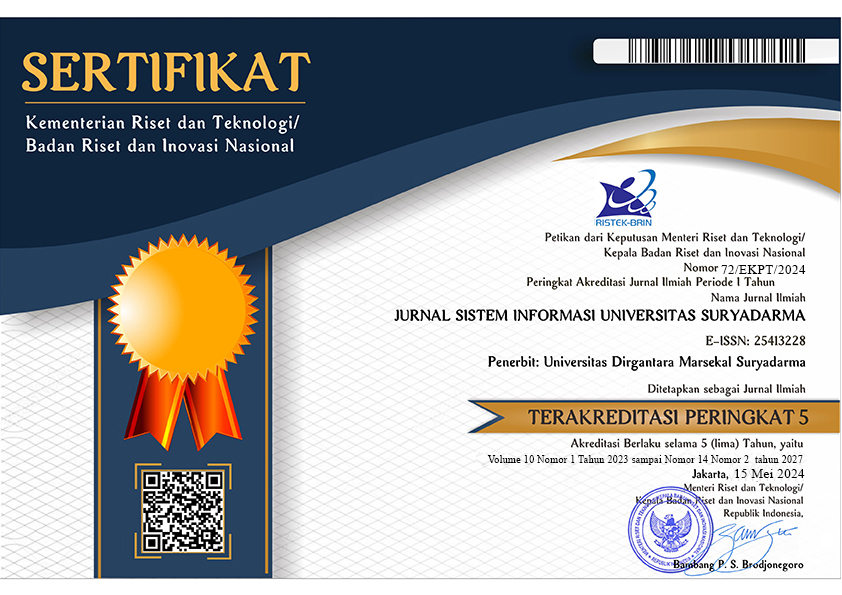
Pengamanan Komputer Menggunakan Kriptografi CIPHER BLOCK CHAINING (CBC)
Sari
In cryptography, a mode of operation is an algorithm that uses a block cipher to encrypt messages of arbitrary length in a way that provides confidentiality or authenticity. A block cipher by itself is only suitable for the secure cryptographic transformation (encryption or decryption) of one fixedlength group of bits called a block. A mode of operation describes how to repeatedly apply a cipher's single-block operation to securely transform amounts of data larger than a block.
Most modes require a unique binary sequence, often called an Initialization Vector (IV), for each encryption operation. The IV has to be non-repeating and, for some modes, random as well. The initialization vector is used to ensure distinct ciphertexts are produced even when the same plaintext is encrypted multiple times independently with the same key. Block ciphers have one or more block size(s), but during transformation the block size is always fixed. Block cipher modes operate on whole blocks and require that the last part of the data be padded to a full block if it is smaller than the current block size. There are, however, modes that do not require padding because they effectively use a block cipher as a stream cipher; such ciphers are capable of encrypting arbitrarily long sequences of bytes or bits.
Historically, encryption modes have been studied extensively in regard to their error propagation properties under various scenarios of data modification. Later development regarded integrity protection as an entirely separate cryptographic goal. Some modern modes of operation combine confidentiality and authenticity in an efficient way, and are known as authenticated encryption modes.
Teks Lengkap:
PDFReferensi
Setiawan Agung, Pengantar Sistem Komputer Edisi Revisi, Informatika, Bandung, 2005.
Bosworth Seymor, Kebay M. E : Computer Security Handbook 4ed, John Wiley & Sons 2002
Check Point Software Technologies: Principles of Network Security, Check Point Software Technologies 2003
Kaye Doug, Loosely Coupled : Missing Pieces of Web Services, RDS Press 2003
Skillsoft Press: Cryptography Protocols and Algorithms, Skillsoft press 2003
Menga Justin, Timm Carl: CCSP: Secure Intrusion Detection and SAFE Implementation Study Guide, Sybex 2004.
Howard Michael: Designing Secure Web-Bases Applications for Microsoft Windows 2000, Microsoft Press 2000
ITU-T: Compendium of Approved ITUT Security Definitions, edition 2003 February, ITU 2003
Peuhkuri Markus: Lecture Material: Securing the Network and Information, 2004
Nguyen Hung Q., Johnson Bob, Hackett Michael: Testing Applications on the Web: Test Planning for Mobile and Internet-Based System 2nd Edition, John Wiley & Sons 2003
Russell Ryan et al., Stealing the Network: How to Own the Box, Syngress Publishing 2003
Koconis David, Murray Jim, Purvis Jos, Wassom Darrin: Securing Linux: A Survival Guide for Linux Security, SANS Institute 2003
Erickson Jon: Hacking: The Art of Exploitation, No Starch Press 2003
Mirza Ahmad David R. Et al.: Hack Proofing Your Network, 2nd Edition, Syngress Publishing 2002
Wang Wallace: Steal This Computer Book 3: What They Won't Tell You About the Internet No Starch Press 2003
Preethan V. V.:Internet Security and Firewalls Premier Press 2002
Brenton Chris, Hunt Cameron: Mastering Network Security 2nd Edition, Sybex 2003
Litlejohn Shinder, Debra : Scene of The Cybercrime - Computer Forensic handbook, Syngress Publishing 2003
Crayton Christopher A.: The Security+ Exam Guide: TestTakers Guide Series. Charles River Media 2003
Schmied Will et al.:MCSE/MCSA Implementing & Administering Security in a Windows 2000 Network Study Guide, Syngress Publising 2003
Kevin Mitnick: The Art of Deception, John Wiley & Sons 2003
Shimonski Robert J. Et al.: The Best Damn Firewall Book Period, Syngress Publishing 2003 Andres Steven, Kenyon Brian: Security Sage’s Guide to Hardening the
Network Infrastructure, Syngress Publishing 2004
CSI/FBI: Computer Crime and Security Survey 2004
Andress Mandy, Cox Phil, Tittel Ed (ed): CIW Security Professional Certification Bible, John Wiley & Sons 2001
Applied Cryptography: Protocols, Algorithms, and Source Code in C, Second Edition. Bruce Schneier, John Wiley & Sons, 1997, ISBN 0-47112845-7
Crypt::CBC Module, Lincoln D. Stein, http://www.cpan.org/ authors/id/L/LD/ LDS/Crypt-CBC-1.00.readme. (diakses tanggal 15 Oktober 2015, 18.00)
http://www.drdobbs.com/webdevelopment/encryption-usingcryptcbc/184416083 (diakses tanggal 15 Oktober 2015, 17.10)
Netcraft: Site Outages for The SCO Group, http://news.netcraft.com/archives/2004/ 05/27/site_outages_for_the_sco_group .html (diakses tanggal 15 Oktober 2015, 20.00)
www.google.com[02-Keamanan_Jaringan_Komputer.pdf] (diakses tanggal 20 Oktober 2015, 20.00)
WWW.Keamanan Jaringan Komputer Tugas individurenderwork - Cara Hacker Mendapatkan Password Anda.mht] (diakses tanggal 20 Oktober 2015, 20.30)
https://en.wikipedia.org/wiki/Block_ciph er_mode_of_operation (diakses tanggal 5 November 2015, 19.15)
http://www.metode-algoritma.com/2016
/01/kriptografi-cipher-block-chainingcbc.html (diakses tanggal 25 Maret 2016, 20.45)
https://cryptobounce.wordpress.com/ta g/kriptografi-simetrik/ (diakses tanggal 25 Maret 2016, 18.38)
DOI: https://doi.org/10.35968/jsi.v3i2.65
Refbacks
Indexed by:





